
A land mine is an explosive device concealed under or on the ground and designed to destroy or disable enemy targets, ranging from combatants to vehicles and tanks, as they pass over or near it. Such a device is typically detonated automatically by way of pressure when a target steps on it or drives over it, although other detonation mechanisms are also sometimes used. A land mine may cause damage by direct blast effect, by fragments that are thrown by the blast, or by both.
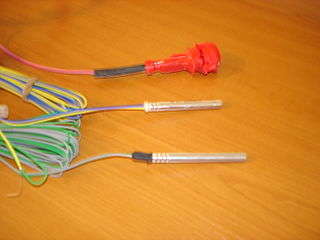
A detonator, frequently a blasting cap, is a device used to trigger an explosive device. Detonators can be chemically, mechanically, or electrically initiated, the last two being the most common.

A mortar is usually a simple, lightweight, man-portable, muzzle-loaded weapon, consisting of a smooth-bore metal tube fixed to a base plate with a lightweight bipod mount and a sight. They launch explosive shells in high-arcing ballistic trajectories. Mortars are typically used as indirect fire weapons for close fire support with a variety of ammunition.

A shell is a payload-carrying projectile that, as opposed to a solid round shot, contains an explosive, incendiary, or other chemical filling, though modern usage sometimes includes large solid kinetic projectiles properly termed shot. Solid shot may contain a pyrotechnic compound if a tracer or spotting charge is used. Originally it was called a bombshell, but "shell" has come to be unambiguous in a military context.
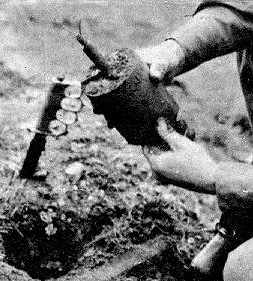
The German S-mine, also known as the "Bouncing Betty" on the Western Front and "frog-mine" on the Eastern Front, is the best-known version of a class of mines known as bounding mines. When triggered, these mines are launched into the air and then detonated at about 1 meter (3 ft) from the ground. The explosion projects a lethal spray of shrapnel in all directions. The S-mine was an anti-personnel mine developed by Germany in the 1930s and used extensively by German forces during World War II. It was designed to be used in open areas against unshielded infantry. Two versions were produced, designated by the year of their first production: the SMi-35 and SMi-44. There are only minor differences between the two models.

Valmara 69 or V-69 is an Italian bounding anti-personnel mine manufactured by Valsella. The mine was developed from the V-59 mine, and although the mine is no longer produced in Italy, a number of copies were produced in other countries e.g. the "SPM-1" manufactured by Singapore.

The Type 89 Grenade Discharger, inaccurately and colloquially known as a knee mortar by Allied forces, is a Japanese grenade launcher or light mortar that was widely used in the Pacific Theater of World War II. It got the nickname the "knee mortar" because of an erroneous Allied belief that these launchers could be fired by propping its plate against the leg. However, anyone trying to fire it this way would receive a severe bruise from its hefty recoil.
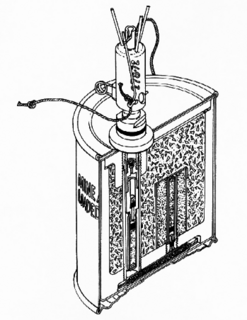
The M16 mine is a United States-made bounding anti-personnel mine. It was based on captured plans of the World War II era German S-mine and has similar performance. The mine consists of a cast iron body in a thin steel sleeve. A central fuze well on the top of the mine is normally fitted with a pronged M605 pressure/tension (tripwire) fuze. Sufficient pressure on the prongs or tension on an attached tripwire causes the release of a striker. The freed striker is forced into a percussion cap which ignites a short pyrotechnic delay. The purpose of this delay is to allow the victim to move off the top of the mine, to prevent its upward movement from being blocked. Once the delay has burned through, a 4.5-gram black powder charge is ignited, which launches the inner iron body of the mine up into the air. The charge also ignites a second pair of pyrotechnic delays.

A fougasse is an improvised mortar constructed by making a hollow in the ground or rock and filling it with explosives and projectiles. The fougasse was used by Samuel Zimmermann at Augsburg in the sixteenth century, referred to by Vauban in the seventeenth century, and well known to military engineers by the mid-eighteenth century. This technique was used in several European wars, the American Revolution, and the American Civil War. The term is still used to describe such devices.

The Stokes mortar was a British trench mortar designed by Sir Wilfred Stokes KBE that was issued to the British and U.S. armies, as well as the Portuguese Expeditionary Corps, during the latter half of the First World War. The 3-inch trench mortar is a smooth-bore, muzzle-loading weapon for high angles of fire. Although it is called a 3-inch mortar, its bore is actually 3.2 inches or 81 mm.

The M2 is a United States bounding anti-personnel mine used during World War II. A number of variants of the mine were produced and although the mine is no longer in US service, it can be found in Cyprus, Iran, Iraq, Korea, Laos, Oman, Rwanda, Tunisia and the Western Sahara. Copies of the mine were produced by Belgium, Pakistan (P7), Portugal (M/966) and Taiwan.

Fragmentation is the process by which the casing of a projectile from a bomb, barrel bomb, land mine, IED, artillery, mortar, tank gun, or autocannon shell, rocket, missile, grenade, etc. is shattered by the detonation of the explosive filler.

The M1935 is a French heavy anti-tank mine. It consists of a large heavy steel base plate with a hinged thin steel lid. Inside the lid it has a rectangular steel container, which holds the explosive charge. The mines are laid at a minimum interval of six feet.
In military munitions, a fuze is the part of the device that initiates function. In some applications, such as torpedoes, a fuze may be identified by function as the exploder. The relative complexity of even the earliest fuze designs can be seen in cutaway diagrams.

A grenade is an explosive weapon typically thrown by hand, but can also refer to a shell shot from the muzzle of a rifle or a grenade launcher. A modern hand grenade generally consists of an explosive charge ("filler"), a detonator mechanism, an internal striker to trigger the detonator, and a safety lever secured by a linchpin. The user removes the safety pin before throwing, and once the grenade leaves the hand the safety lever gets released, allowing the striker to trigger a primer that ignites a fuze, which burns down to the detonator and explodes the main charge.

An artillery fuze or fuse is the type of munition fuze used with artillery munitions, typically projectiles fired by guns, howitzers and mortars. A fuze is a device that initiates an explosive function in a munition, most commonly causing it to detonate or release its contents, when its activation conditions are met. This action typically occurs a preset time after firing, or on physical contact with or detected proximity to the ground, a structure or other target. Fuze, a variant of fuse, is the official NATO spelling.
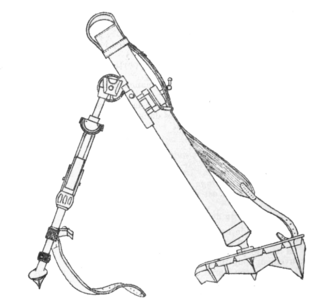
The Brandt Mle 1935 60-mm mortar was a company-level indirect-fire weapon of the French army during the Second World War. Designed by Edgar Brandt, it was copied by other countries, such as the United States and China, as well as purchased and built by Romania. Modified in 1944, the mortar continued to be used by France after the war until at least the 1960s.
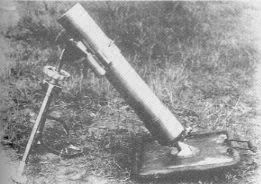
The Type 99 81 mm mortar was a Japanese mortar used primary by Imperial Japanese Army during World War II. The Type 99 designation was given to this gun as it was accepted in the year 2599 of the Japanese calendar (1939). The Type 99 81 mm mortar is typical of the Stokes-Brandt type mortar. The Type 99 81 mm mortar differs from the Type 97 81 mm infantry mortar in the shortness of its tube and in the method of firing. The differences between the Type 99 and the US 81-mm mortar, M1 are pronounced.

The AB 250-2(Abwurfbehälter) was a cluster bomb used by the Luftwaffe during World War II.
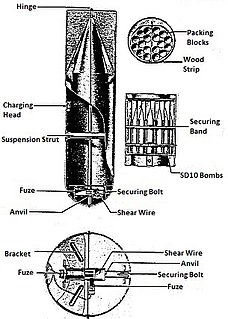
The AB 500-1(Abwurfbehälter) was a cluster bomb used by the Luftwaffe during World War II.


















